 The Report from Miami The Report from Miami So a buddy of mine is in Miami. It’s a vacation of sorts. He’s sending me these photos of what he’s seeing as he’s relaxing with his wife under the south Florida sunshine. My thoughts are conflicted between the desire to sit and relax under a palm with a cool drink while taking in the sea breeze and the knowledge of what that place was like before Julia Tuttle sent Henry Flagler that box of orange blossoms. It’s that conflict that leads to the assertions about the “real Florida,” the “real Georgia,” and the “real South.” The misery experienced through the eyes of Sol MacIvey as he leaves Miami forever in the opening of Patrick Smith’s epic A Land Remembered grips us and makes us woeful of the development that trashed an Eden-like place, scattered the noble previous inhabitants and threatened the vitality of the Everglades. But we also see an adaptation that allows people to relax and enjoy themselves. We see people who use this opportunity to provide a living for themselves and their families. We see the conflict between nature and “progress.” What we have to discern is: what exactly is progress? William Faulkner famously said “They call it progress, but they don’t say where it’s going.” Previously, another prolific Southern writer championed the concept of the “New South.” Henry Grady gave speeches throughout the land that heralded a progressive future in the South. When we see the results of this vision, the question arises: did we do the right thing? “They call it progress but they don’t say where it is going.” - William Faulkner  Henry Grady, the Spokesman of the New South Henry Grady, the Spokesman of the New South Progress has brought overcrowding, traffic gridlock, pollution, crime, taxes, a lack of affordable housing, and a vast destruction of natural resources. Southern culture has fallen under siege and is being subjugated by a new one brought by people who talk funny and are constantly spouting off about the way they do things where they came from. With all that in mind, we must consider the reality of progress. That requires us to define what progress really is. Progress can be a good thing. I might not be a fan of the bright lights and big city but I also don’t care to walk to a privy in the rain just to finish the trek with a corncob. Electricity, indoor plumbing, and air conditioning are all ok with me. We also love some of Grady’s points: locally and regionally sourced goods benefit our economy and way of life, for example. It is also true that nothing lasts forever. We can’t reasonably preserve everything. Time marches on and it carries us with it. But we aren’t helpless. We have options. We need to address progress by setting standards and asking questions. Progress should provide more than it takes. Progress should not be merely economic. Does it improve or hinder our culture? Does it improve or hinder our environment? Does it really improve our economy or does it vacuum our wealth to some other locations? (Think Walmart) Does it address Faulkner’s concerns? Where is it going? If it costs us our culture, costs us our environment, costs us our souls, it’s not progress. That, my friends, is poison. We must resent and resist efforts to poison our land. We must use wisdom to determine what is true progress and what is just modernity taking us for a ride.
0 Comments
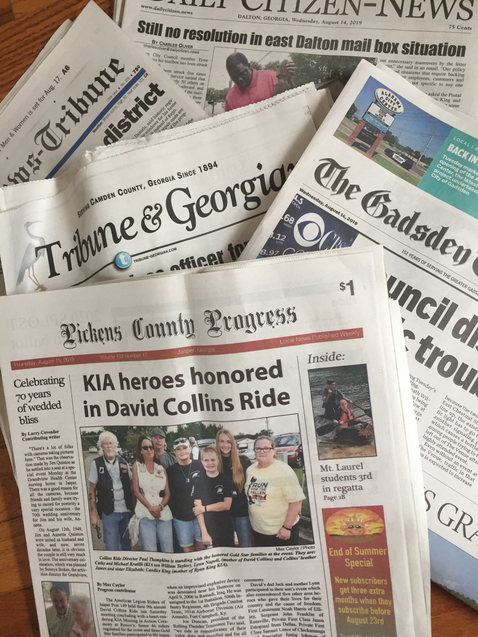 Small Town Papers are Boots on the Ground, Holding Local Power Accountable Small Town Papers are Boots on the Ground, Holding Local Power Accountable Sam Burnham, Curator A story in a large, nationally-known newspaper shines a light on the current struggle of small newspapers nationwide. The Vindicator, a local newspaper in Youngstown, Ohio will cease publication on August 31. The paper made this announcement just days after celebrating its 150th anniversary. The Vindicator has been owned by the same family since the 1880s. You’re probably not familiar with The Vindicator. I didn’t know about it until reading of its demise and I’m a bit of a newspaper junkie. I love checking out the local paper in towns we visit and I’m a sucker for a small town paper. I wrote for my high school paper and I submit editorials to my own local paper. Just for some background, Youngstown, Ohio is the buckle of the Rust Belt. The town is struggling with a collapsing economy as industries have shuttered their operations there. It has been a domino effect as losses in big industry have led to losses in small businesses. Ultimately one of the falling dominos was The Vindicator. Operating a newspaper these days can be a challenge. News moves fast and by the time a story comes off the press, television, radio, or digital media have ran with it and moved on. This is especially the case for weekly papers, which are common in small towns. But local papers can also offer stories you might not find elsewhere. Local features, sports, and editorials that shape local policy and hold the powerful accountable. You won’t hear about local corruption on Fox News, TRONC, or Huffpo.  The 1st Amendment Protects Semi & Fully Automatic Presses. The 1st Amendment Protects Semi & Fully Automatic Presses. My love for local papers fuels the use of those stories at ABG. You’ll see stories from these papers linked in our social media and cited in our stories. Whether it’s the Pickens Progress, The Tribune & Georgian, The Dalton Daily Citizen, or the Tifton Gazette, small town papers are boots on the ground, finding out what’s really going on in the world. Obviously there are multiple forces at work in the demise of The Vindicator. The overall economic situation in Youngstown is likely the biggest factor. I don’t know enough about the paper to comment on the need for papers to evolve and adapt to the times. But there’s one other factor that we all need to be aware of. Just as business and government need to be decentralized, even more so the media needs it. We need small newspapers, small radio stations, small television stations. Of those three, newspapers find a way to exist where the other two don’t. When one of them dies, particularly one that is 150 years old, it stings and we are all a little poorer for it. It’s the proverbial canary in the coal mine. There is nothing we can do to change the fate of The Vindicator. But in a state that gave us newspaper legends like Henry Grady, Joel Chandler Harris, Margaret Mitchell, Lewis Grizzard, “Bill Arp,” and Bo Whaley, we can preserve that rich history and assure this media platform endures and produces more generations of reporters, writers, photographers, thinkers, and that they hold local power accountable. That requires us to play our part. Support local media, particularly your local newspaper. 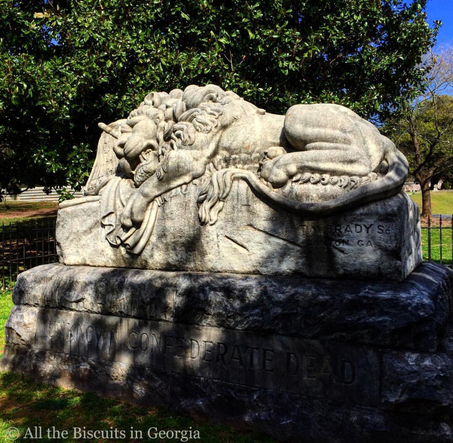 The Lion of Atlanta The Lion of Atlanta Sam Burnham, Curator The City of Atlanta, in their infinite wisdom, has seen fit to add “contextualization” to many historic markers and monuments. This action was put into motion by former mayor Kasim Reed whose administration continues to be the subject of multiple corruption investigations. One site adding “contextualization” is Oakland Cemetery. Oakland is a true jewel of Atlanta. We’ve featured the cemetery here as well as on our Instagram on multiple occasions. It’s natural and architectural beauty as well as its historic significance make it an oasis of Victorian charm in a modern city that doesn’t hesitate to demolish the past. So let’s take a look at these new markers the city has placed at Oakland. At issue is the Lion of Atlanta and the Confederate obelisk. These monuments stand in the Confederate section where close to 7000 soldiers lie in the soil. As a transportation hub, Atlanta became a makeshift medical Mecca for wounded and dying soldiers from battles such as Chickamauga, Resaca, and Kennesaw Mountain. After the war, many soldiers buried hastily in battlefield graves were reinterred at Oakland. The 65 foot tall obelisk, the tallest structure in Atlanta at the time, and the Lion of Atlanta were placed to recognize the dead. These are not “Lost Cause” monuments. The fact that the lion stands over a field of some 3000 unknown soldiers, most of whom lie in unmarked graves, means that this monument, recognized as a significant work of art by The Smithsonian, serves as a proper burial marker for those who died defending their homes and families. 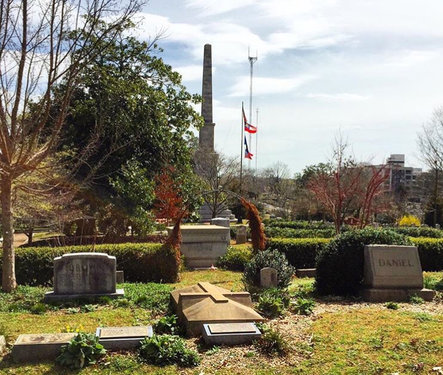 The Confederate Obelisk Towers Over Oakland The Confederate Obelisk Towers Over Oakland Which brings us to the cause. There remain two myths about the cause of the war. One myth would have us believe that the war had nothing to do with slavery. The other myth would have us believe that it was all about slavery. Both of these are lies and the people pushing both know they are lies. The truth is that the struggle between state sovereignty and centralized power in America predates the Constitution. The war was inevitable because of these two factors: slavery and the question of sovereignty. But one truth must be told. The 7000 men who lie at Oakland are mostly common soldiers. Most owned no slaves and had little investment in maintaining that institution. If they were from Tennessee, North Carolina, Alabama, Mississippi, or north Georgia, the scourge of war had already threatened, if not decimated their homes. These were the men who, like the soldier in Shelby Foote’s narrative, were “fighting because you’re down here.” Fellow Georgian and lover of history and Oakland Cemetery, Eb Joseph Daniels, put it this way and I quite agree: “The new contextualization plaques are up at Historic Oakland Cemetery. While the text is far less leading than the inscription planned by the DeKalb County Commission to adorn the DeKalb County Confederate Memorial Obelisk, I do feel that it was remiss to include the modern assessment of the function of Confederate monuments on the plaque which acknowledges the Lion of the Confederacy.The Lion is effectively a headstone, and therefore seems a poor spot for academic discourses which, I feel, would seem better suited for the obelisk, which is not the marker for any individual grave. Nevertheless, working within the constraints placed by the City of Atlanta, I think that the Historic Oakland Foundation did the very best job that it could under the circumstances. There is lots of good and valuable information here which will help enlighten visitors who do not take a tour or purchase a guidebook.” 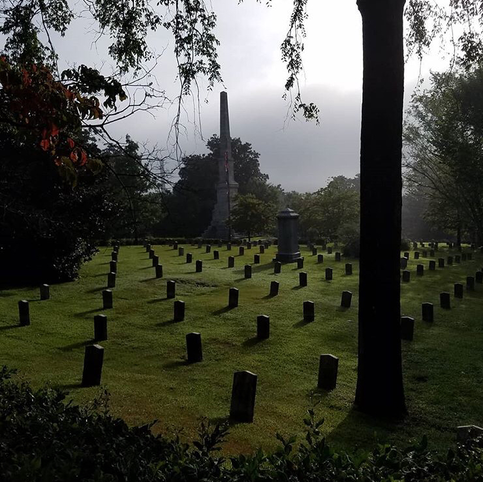 Photo Credit: Eb Joseph Daniels - @all.points.south Instagram Photo Credit: Eb Joseph Daniels - @all.points.south Instagram Daniels and I are also in agreement that the third marker for the Confederate Memorial Grounds was more tastefully done. Neither of us think the City of Atlanta had any mandate on this marker. As for the Lion of Atlanta and the Confederate Obelisk, these are not Lost Cause monuments. “Contextualization” tying them to the Lost Cause is done in poor taste. They are grave markers. And while there are monuments that should be accompanied by contextualization, the City of Atlanta is carrying it too far by insisting on marking those that don’t need it and also by skewing the new narrative too far in the other direction. The war was complex and understanding it requires a depth of inquiry that can’t be facilitated on a monument or a contextualization marker. We need contextualization that will provoke questions and conversations - a search for truth rather than pontification from the thought police. |
Sam B.Historian, self-proclaimed gentleman, agrarian-at-heart, & curator extraordinaire Social MediaCategories
All
Archives
November 2022
|





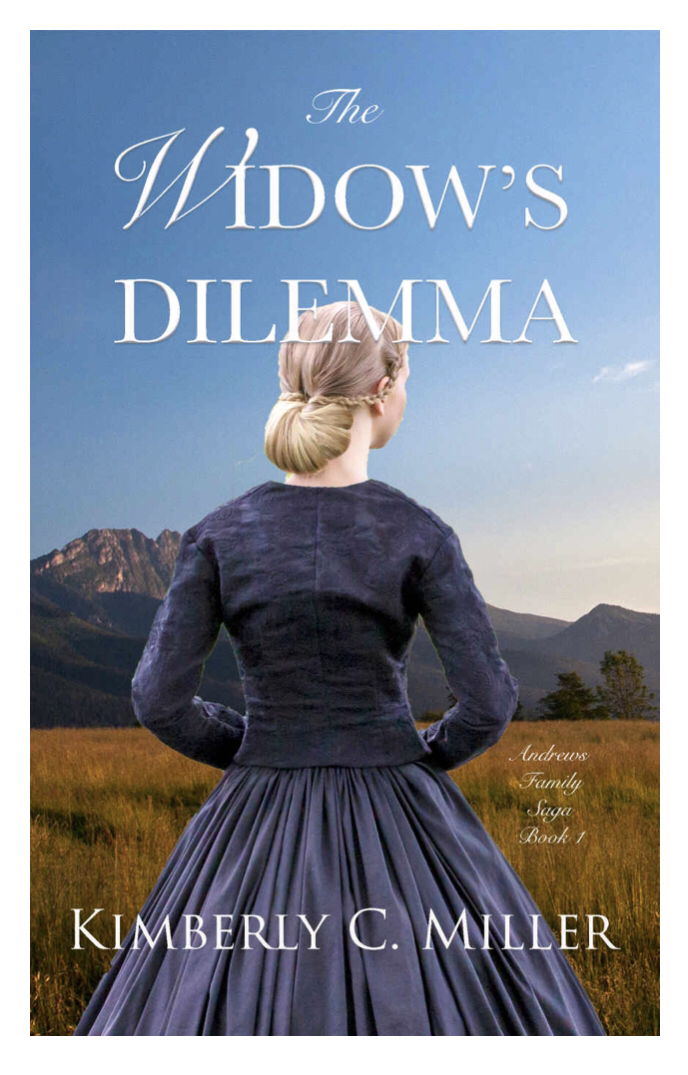
 RSS Feed
RSS Feed
